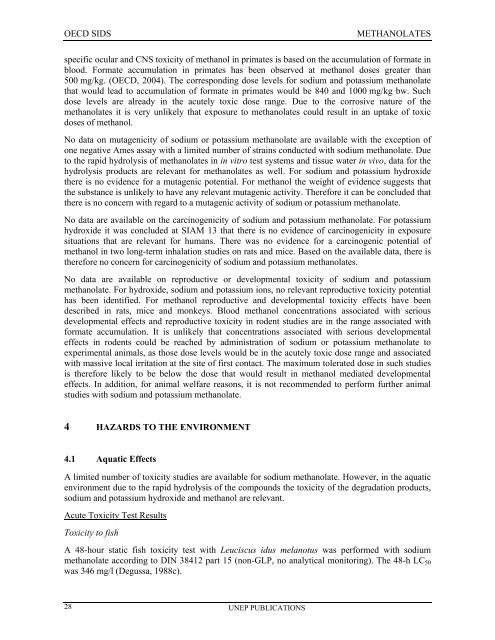Sodium methanolate - ipcs inchem
Sodium methanolate - ipcs inchem
Sodium methanolate - ipcs inchem
You also want an ePaper? Increase the reach of your titles
YUMPU automatically turns print PDFs into web optimized ePapers that Google loves.
OECD SIDS<br />
METHANOLATES<br />
specific ocular and CNS toxicity of methanol in primates is based on the accumulation of formate in<br />
blood. Formate accumulation in primates has been observed at methanol doses greater than<br />
500 mg/kg. (OECD, 2004). The corresponding dose levels for sodium and potassium <strong>methanolate</strong><br />
that would lead to accumulation of formate in primates would be 840 and 1000 mg/kg bw. Such<br />
dose levels are already in the acutely toxic dose range. Due to the corrosive nature of the<br />
<strong>methanolate</strong>s it is very unlikely that exposure to <strong>methanolate</strong>s could result in an uptake of toxic<br />
doses of methanol.<br />
No data on mutagenicity of sodium or potassium <strong>methanolate</strong> are available with the exception of<br />
one negative Ames assay with a limited number of strains conducted with sodium <strong>methanolate</strong>. Due<br />
to the rapid hydrolysis of <strong>methanolate</strong>s in in vitro test systems and tissue water in vivo, data for the<br />
hydrolysis products are relevant for <strong>methanolate</strong>s as well. For sodium and potassium hydroxide<br />
there is no evidence for a mutagenic potential. For methanol the weight of evidence suggests that<br />
the substance is unlikely to have any relevant mutagenic activity. Therefore it can be concluded that<br />
there is no concern with regard to a mutagenic activity of sodium or potassium <strong>methanolate</strong>.<br />
No data are available on the carcinogenicity of sodium and potassium <strong>methanolate</strong>. For potassium<br />
hydroxide it was concluded at SIAM 13 that there is no evidence of carcinogenicity in exposure<br />
situations that are relevant for humans. There was no evidence for a carcinogenic potential of<br />
methanol in two long-term inhalation studies on rats and mice. Based on the available data, there is<br />
therefore no concern for carcinogenicity of sodium and potassium <strong>methanolate</strong>s.<br />
No data are available on reproductive or developmental toxicity of sodium and potassium<br />
<strong>methanolate</strong>. For hydroxide, sodium and potassium ions, no relevant reproductive toxicity potential<br />
has been identified. For methanol reproductive and developmental toxicity effects have been<br />
described in rats, mice and monkeys. Blood methanol concentrations associated with serious<br />
developmental effects and reproductive toxicity in rodent studies are in the range associated with<br />
formate accumulation. It is unlikely that concentrations associated with serious developmental<br />
effects in rodents could be reached by administration of sodium or potassium <strong>methanolate</strong> to<br />
experimental animals, as those dose levels would be in the acutely toxic dose range and associated<br />
with massive local irritation at the site of first contact. The maximum tolerated dose in such studies<br />
is therefore likely to be below the dose that would result in methanol mediated developmental<br />
effects. In addition, for animal welfare reasons, it is not recommended to perform further animal<br />
studies with sodium and potassium <strong>methanolate</strong>.<br />
4 HAZARDS TO THE ENVIRONMENT<br />
4.1 Aquatic Effects<br />
A limited number of toxicity studies are available for sodium <strong>methanolate</strong>. However, in the aquatic<br />
environment due to the rapid hydrolysis of the compounds the toxicity of the degradation products,<br />
sodium and potassium hydroxide and methanol are relevant.<br />
Acute Toxicity Test Results<br />
Toxicity to fish<br />
A 48-hour static fish toxicity test with Leuciscus idus melanotus was performed with sodium<br />
<strong>methanolate</strong> according to DIN 38412 part 15 (non-GLP, no analytical monitoring). The 48-h LC 50<br />
was 346 mg/l (Degussa, 1988c).<br />
28<br />
UNEP PUBLICATIONS
















